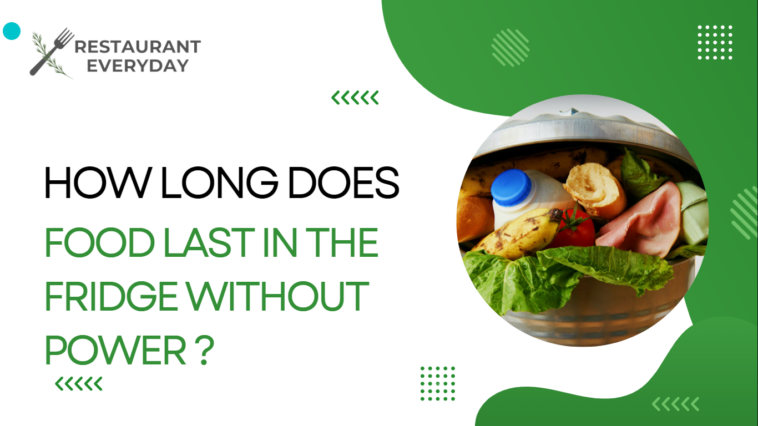Refrigeration is the cornerstone of preserving food freshness, but unexpected power outages can jeopardize this. Understanding how long does food lasts in the fridge without power is crucial to prevent food spoilage and potential health risks. Typically, a refrigerator can sustain safe temperatures for about four hours once the power goes out.
When it comes to preserving the freshness of our food, refrigeration stands as a vital tool whether it is for domestic use or a professional restaurant setup. It effectively slows down the growth of bacteria, keeping perishable items safe for consumption over extended periods. However, the reliability of refrigeration is deeply intertwined with a consistent power supply. Unexpected power outages pose a significant threat to the integrity of our stored food items.
Understanding the timeline of food safety during such situations is key. How long can food maintain its safety within the confines of a refrigerator without power? This knowledge becomes a crucial factor in averting food spoilage and the potential health risks associated with consuming compromised items.
Factors Affecting Food Spoilage in case of Power Outage
The stability of refrigerated food during a power outage depends on several factors. Temperature fluctuations within the refrigerator, the type of food stored, and the duration of the outage significantly impact the safety of perishable items.
Role of ambient temperature
- The ambient temperature surrounding the refrigerator plays a pivotal role; higher temperatures outside can expedite the rise in internal temperature, accelerating food spoilage.
- Additionally, the initial temperature within the fridge before the outage, the fridge’s insulation quality, and how frequently it’s opened during the outage can significantly influence this timeframe of food preservation in case of power outage.
Influence of Initial refrigerator temperature
- Moreover, the starting temperature within the refrigerator before the power interruption and the quality of its insulation hold considerable sway.
- A lower initial temperature grants a more extended buffer before food temperatures rise to unsafe levels.
- Similarly, the insulation’s effectiveness determines the refrigerator’s ability to retain coldness, thereby extending the viability of perishable items.
Frequency of opening during power outage
- An often-overlooked factor lies in the frequency of opening the refrigerator during the outage.
- Each time the fridge is opened, warm air infiltrates its confines, contributing to a hastened temperature rise.
- Limiting unnecessary access to the refrigerator can help preserve its internal temperature, prolonging the safety of stored food.
In a nutshell, a multitude of interconnected factors dictates the stability of refrigerated food during power outages. Understanding and managing these elements, including external temperatures, starting fridge temperature, insulation quality, and prudent access, play pivotal roles in prolonging the viability of perishable items and safeguarding against premature spoilage. Especially i f you are in the culinary business, you need to be extra vigilant in terms of the quality of food you provide. Therefore, you must have backup power supply options to avoid serving compromised food which can result in legal actions against you by the customers.
What should I throw out of the freezer after a power outage?
After a power outage, determining what to discard from the freezer and how to manage the food wastage, is a crucial decision to ensure food safety no matter if you are a homemaker or a professional food setup. Firstly, perishable items that have thawed and reached temperatures above 40°F (4°C) for over two hours should be discarded. This includes meats, seafood, and poultry that are no longer frozen solid. Even if these items still have ice crystals or are cold to the touch, their safety cannot be guaranteed after extended exposure to higher temperatures.
Additionally, any frozen foods that show signs of refreezing, indicated by ice crystals or refrozen liquid, might still be safe for consumption. However, their quality may have deteriorated, resulting in changes in taste, texture, or overall integrity. While these foods might be considered safe, assessing their quality becomes essential. Items with noticeable changes or a loss of integrity should be discarded to avoid any potential health risks.
Finally, relying on your judgment and the specifics of each food item is crucial. Use-by dates, packaging integrity, and odors are essential indicators. If any frozen food item exhibits signs of spoilage such as an off odor, strange appearance, or an unusual texture, it’s safer to discard it. When in doubt about the safety or quality of any frozen food item, it’s best to err on the side of caution and dispose of it to prevent the risk of foodborne illness.
| Items to Discard from Freezer After Power Outage | Guidelines |
| Perishable items thawed above 40°F (4°C) for over two hours | – Meats, seafood, poultry no longer frozen solid should be discarded, even if they have ice crystals or feel cold to the touch. |
| Frozen foods showing signs of refreezing (ice crystals, refrozen liquid) | – Items might be safe but can experience changes in taste, texture, or overall quality. Assessing quality is essential. |
| Foods with noticeable changes or loss of integrity | – Use-by dates, packaging integrity, odors, and any signs of spoilage such as off odors, strange appearance, or unusual texture should prompt discarding. |
| Items with doubts about safety or quality | – When uncertain, err on the side of caution and dispose of any frozen food items to avoid potential health risks. |
What foods get most affected after a power outage?
The durability of various food items diverge significantly when subjected to the challenges of a power outage which raises the question how long does food last in the fridge without power . Delving into the specifics, dairy products such as milk, cheese, and yogurt emerge as particularly susceptible to accelerated spoilage. The relatively short shelf life of these items under such circumstances necessitates swift action to prevent wastage and potential health risks due to TCS food.
On the front lines of perishability, meat, poultry, and seafood stand as the most vulnerable contenders. Their high protein content makes them breeding grounds for bacteria when left unrefrigerated. Therefore, these items demand immediate attention and consideration, prompting a proactive approach to either consume, preserve, or discard them promptly during power outages.
In contrast, fruits and vegetables and bioengineered food items like corn, soybeans etc., exhibit a comparatively more resilient stance in the face of a disrupted power supply. While they may endure slightly longer without refrigeration, a critical eye must be cast upon them. Regular inspections for any signs of spoilage, such as changes in texture, appearance, or aroma, become paramount. This meticulous scrutiny ensures that even seemingly hardy items are not unwittingly incorporated into meals, maintaining overall food safety.
Leftovers and cooked foods also have a limited shelf life without refrigeration. It’s essential to assess their safety before consumption after a power outage.
How to preserve food during power outages?
Implementing precautionary measures can significantly extend the duration for which the food items remain safe for consumption. From strategic packing and insulation of the refrigerator to leveraging coolers or ice packs, these proactive steps play a pivotal role in preserving the freshness and safety of food during times of power disruption.
Proper Refrigerator Packing and Insulation
- Pack the refrigerator densely to minimize empty spaces, aiding in better cold retention.
- Insulate the refrigerator with blankets or insulating materials to shield against external temperature fluctuations.
Utilize Coolers or Ice Packs
- Transfer essential perishable items to coolers or use ice packs to maintain lower temperatures, extending their shelf life during power outages.
- Ideal for crucial items like medications, baby food, or perishable foods necessary for immediate consumption.
Regular Monitoring and Temperature Checks
- Continuously monitor food temperatures using a thermometer for freezer and refrigerator, to assess their safety.
- Swiftly identify signs of spoilage, such as changes in appearance, texture, or odor, to promptly discard compromised items.
Conclusion: How Long Does Food Last in the Fridge Without Power?
In emergencies like power outages, understanding food storage guidelines becomes paramount. Being prepared and knowledgeable about how long food remains safe without power, identifying signs of spoilage, and taking precautionary measures can prevent food waste and safeguard against potential health hazards.
Hence, whether you are starting a professional restaurant in 2024 or a lay man, you need to be educated and trained for how to act smart in times of resource emergencies like elongated power outages. Make sure you properly manage the food items stored in your fridge to lessen the risk of food going bad due to no electric supply.
By adhering to these guidelines and staying proactive in managing food supplies during power outages, individuals can ensure food safety for themselves and their families. Be vigilant in food inspection specifically after power outages so that you can discard the compromised food. Stick to the when in doubt throw it out rule when it comes to food items with shorter shelf life or prominent spoilage symptoms.




